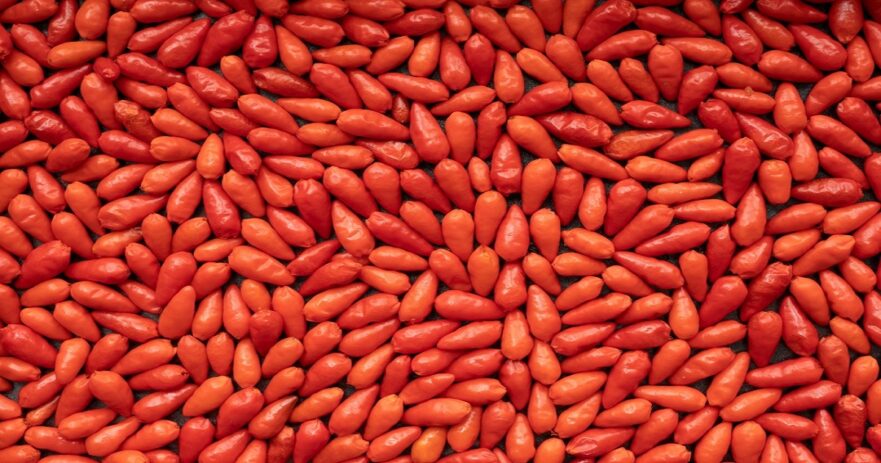In this article about pequin pepper:
🗺️ Origin and history | 🌶️ Uses | ✨ Appearance and taste | 🌶️ Types | 🧑🌾 Growing – gardening | 👨🍳 Cooking – recipes | 🛒 Where to buy | 🫙 How to store | 👨⚕️ Health benefits | 🌶️ Alternatives and substitutes | ❓ Frequently asked questions
What is a Pequin pepper?
Pequin is a chili pepper well-known for its intense heat and nutty, smoky, fruity flavor. These small, oval peppers are usually red and known for their small size, which is deceptively proportional to the heat they pack.
Pequin peppers originate in Mexico and are significant in Mexican and Southwestern US cuisine. They’re frequently found in sauces, salsas, and spice blends, adding a robust heat and distinct flavor to various dishes.
| Pequin pepper | |
| SHU | 30,000 - 60,000 |
| Median SHU | 45,000 |
| Flavor | Fruity with citrusy undertones, smoky, nutty, and quite hot |
| Species | Capsicum annuum |
| Origin | Mexico |
| Uses | Salsas, sauces, pickling, and as a spicy seasoning |
Are Pequin peppers spicy? How hot are they?
Pequin pepper Scoville: 30,000 to 60,000 SHU
Pequin peppers are extremely spicy, with a heat level that exceeds that of many other chili peppers. They have a Scoville heat unit range of 30,000 to 60,000, making them up to 24 times hotter than a jalapeño, which has a Scoville heat unit range of 2,500 to 8,000.
Pequin peppers, despite their small size, pack a powerful punch, often surprising those who underestimate their heat due to their diminutive size. As a result, they are popular among those who enjoy a fiery kick in their dishes, adding heat and a distinct smoky, fruity flavor.
🗺️ ORIGIN AND HISTORY
Where do Pequin peppers come from?
Pequin peppers originated in Mexico, where they have been a part of the culinary and cultural traditions for hundreds of years. These small but fiery peppers were essential to indigenous cuisine, valued for their intense heat and distinct, smoky flavor. The name “Pequin” is thought to be derived from the Spanish term “pequeño,” which refers to its small size.
These peppers are still primarily grown in Mexico, but cultivation has spread to the southern United States, particularly Texas, where they are a staple in many traditional dishes. Pequin peppers, despite their growing popularity, remain a beloved symbol of Mexican culinary heritage.
🌶️ USES
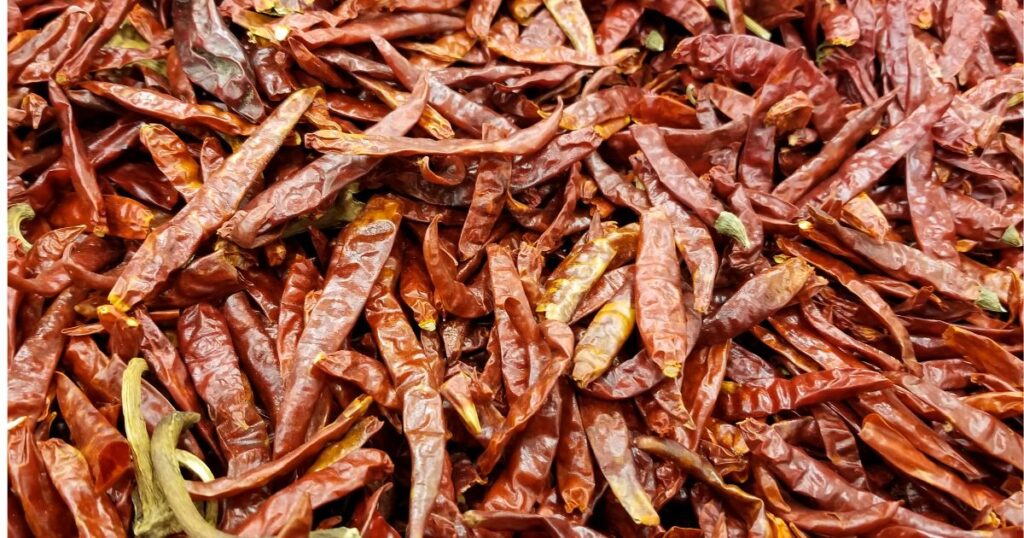
What are Pequin peppers good for? How to use them?
Pequin peppers are versatile ingredients with numerous culinary applications. These fiery little peppers can pack quite a punch, adding a distinct heat and smoky, nutty flavor to various dishes.
A popular form of this pepper is dried chili Pequin. The peppers are dehydrated and ground to powder to make a versatile spice used in several dishes. Add it to stews, soups, and sauces for a spicy kick, or sprinkle it on grilled meats, roasted vegetables, or pizza for a flavor boost. The dried Pequin peppers’ smoky, nutty undertones elevate the overall flavor profile of any dish.
Another interesting way to use these peppers is in vinegar. The peppers are pickled in vinegar, which keeps the heat but adds a tangy twist. This preparation is an excellent condiment for sandwiches and tacos and a fiery addition to salads. The vinegar base also complements the natural heat of the Pequin pepper, resulting in a well-rounded flavor.
Including Pequin peppers in salsas and hot sauces is an excellent way to incorporate their distinct flavor and fiery heat into meals. These sauces can add a spicy kick to tacos, burgers, or wings. The smoky flavor of the peppers combines with the other ingredients to create a well-balanced, spicy, and delicious condiment.
✨ APPEARANCE AND TASTE
What do Pequin peppers look like?
Pequin peppers are small and oval-shaped, typically about half an inch to ¾ inch in size. They have a smooth, glossy surface that ripens from green to red. These chilies may appear unassuming with their compact shape, but their potent heat distinguishes them from many larger varieties. Pequin peppers dry to a rich reddish-brown color, indicating their intense, concentrated flavor.
What does Pequin pepper taste like?
Pequin peppers have a fascinating flavor profile combining fiery heat and nuanced flavor profiles. The first bite may have a slightly fruity, nutty, and smoky flavor, a delicious preamble to the following fiery heat. The Pequin pepper’s heat is impressive, especially given its small size. Despite their high heat, chefs value them for the rich, layered flavor they bring to the table. Pequin peppers are a popular chili among those who enjoy complex and spicy flavors due to their unique combination of smoke, heat, and citrusy fruitiness.
🌶️ TYPES
What are the different types of Pequin Peppers?
Pequin peppers, like many other chilies, come in various colors, each with its own flavor profile. Yellow, black, and purple Pequin peppers are among them.
Yellow Pequin, a rare pepper, stands out because of its bright, eye-catching color. Furthermore, it has a subtly fruity flavor that complements its intense heat, balancing sweetness and spice. Their bright color and intense flavor make them an excellent addition to salsas and hot sauces, where their distinct properties can shine.
Black Pequin peppers have a dark, almost charcoal-like coloring. As a result, these peppers make a bold visual statement in dishes, adding an unexpected twist to classic dishes.
Purple Pequin peppers have a deep, rich purple color. The heat of these peppers is as intense as their vibrant color, with a fruity and mildly smoky undercurrent. However, these peppers are more than just hot; their vibrant purple color adds visual interest to any dish, making them an excellent choice for creating a memorable dining experience.
🧑🌾 GROWING – GARDENING
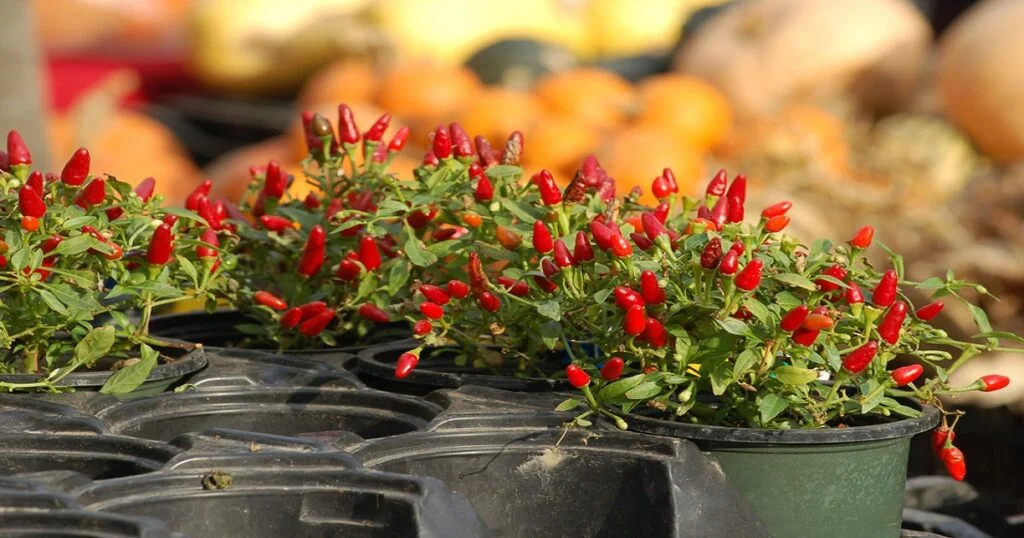
How to grow Pequin Pepper?
If you want to grow your own chili peppers, Pequin peppers are an intriguing option. These peppers grow best in sunny to partly sunny locations and warm climates, and they can be grown in garden soil or pots for a more controlled environment. Planting Pequin peppers in well-drained soil and keeping a consistent watering schedule is essential for success. The use of fertilizers can also help them grow healthy.
When to pick Pequin Pepper?
Pequin peppers typically take 75 to 90 days after transplanting to reach full maturity, depending on the growing conditions. Regularly harvesting these mature peppers encourages further growth and increases overall yield. Growing these distinct peppers can be a rewarding experience whether you’re an avid gardener or a chili fan.
👨🍳 COOKING – RECIPES
Cooking / Recipe ideas for Pequin Pepper
Pequin peppers, known for their fiery kick and distinct, smoky flavor, can season many dishes. Chili Pequin pepper sauce is a particularly exciting recipe to try. For a balanced, spicy addition to your meals, combine Pequin peppers with garlic, onions, vinegar, herbs, and a touch of sweetener. This sauce can add a kick of heat to anything from grilled meats to scrambled eggs.
Chili Pequin jelly can achieve an intriguing combination of sweet and spicy. The sweetness of fruit preserves balances the heat of Pequin peppers in this condiment. It is a delicious addition to toast, served with cream cheese and crackers, and even as a glaze for grilled meats.
Chile Pequin jam, similar to jelly, is another sweet-spicy treat made with these hot peppers. For an adventurous breakfast, spread the jam on bread, add it to a cheese platter, or use it as a topping for pancakes or waffles.
Pequin chile salsa is a versatile recipe that combiness the fiery punch of Pequin peppers with the freshness of tomatoes, onions, and cilantro. This salsa pairs well with tortilla chips and tacos and as a topping for grilled chicken or fish.
Whatever the recipe, remember that a little goes a long way when it comes to Pequin peppers. They are a potent ingredient because of their high heat, so use them sparingly to avoid overpowering your dishes.
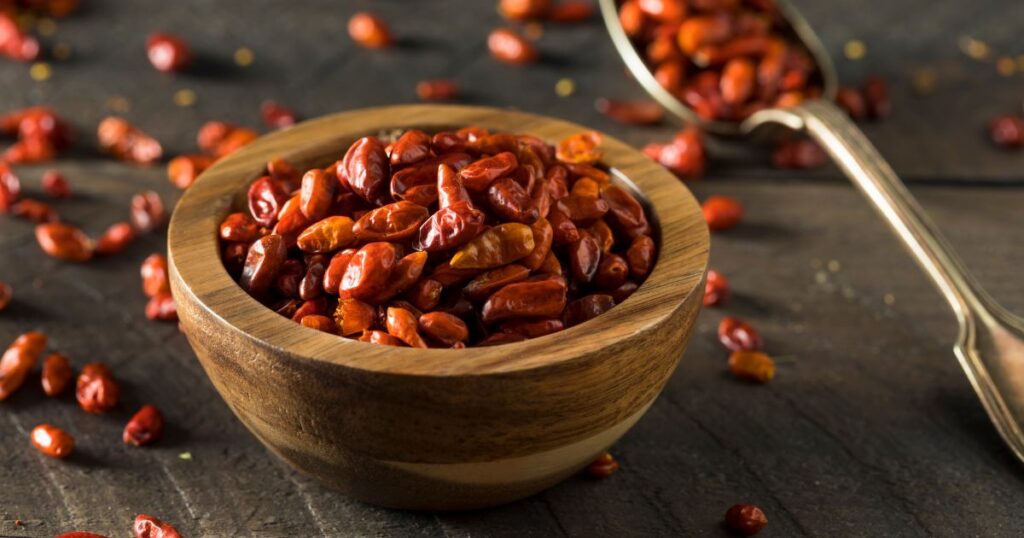
🛒 WHERE TO BUY
Where can I buy Pequin Peppers?
Pequin peppers, either fresh or dried, are commonly found in certain grocery stores. However, if they are not readily available at your local supermarket, it is worth checking out specialty food stores, international markets, or farmers’ markets. You can also order Pequin peppers online from various vendors, who will ship them directly to your home.
When shopping, look for firm Pequin peppers with vibrant colors. Avoid peppers that appear soft, wrinkled, or have dark spots, as these signs may indicate that they are past their prime.
Aside from fresh or dried peppers, various Pequin pepper products are available, such as hot sauces and powders, typically found in grocery stores’ spice or condiment aisles or online.
Where can I buy Pequin Pepper plants?
Pequin pepper plants are available at garden centers and nurseries that sell vegetable plants. Furthermore, these plants are available from a variety of online vendors.
Choose Pequin pepper plants that are healthy, with sturdy stems and lush green leaves. Avoid plants that appear wilted or have yellow leaves, as they may be unhealthy.
Where can I buy Pequin Pepper seeds?
Pequin pepper seeds can be purchased online or at local garden centers for those interested in growing their own plants from seed. When sowing Pequin pepper seeds, follow the instructions on the seed packet and place them in a location with plenty of sunlight and well-draining soil.
🫙 HOW TO STORE
How do I store Pequin Peppers?
You can store fresh Pequin peppers in the refrigerator for about two weeks. If you want to keep them longer, place the peppers in an airtight container or a sealed plastic bag and stash it in the crisper drawer of your refrigerator.
Store dried Pequin peppers and other derivative products, such as powders, in a dry and cool area away from direct sunlight. Keeping these in airtight containers will ensure their freshness and prevent moisture from seeping in.
Can Pequin Peppers be frozen?
Yes. You can freeze Pequin peppers for future use. To begin, thoroughly wash the peppers and remove their stems. Then, place the peppers on a baking sheet in a single layer and freeze for several hours. Transfer the frozen peppers to an airtight container or a plastic freezer bag. You can keep them in the freezer for up to 6 months.
❤️🩹 HEALTH BENEFITS
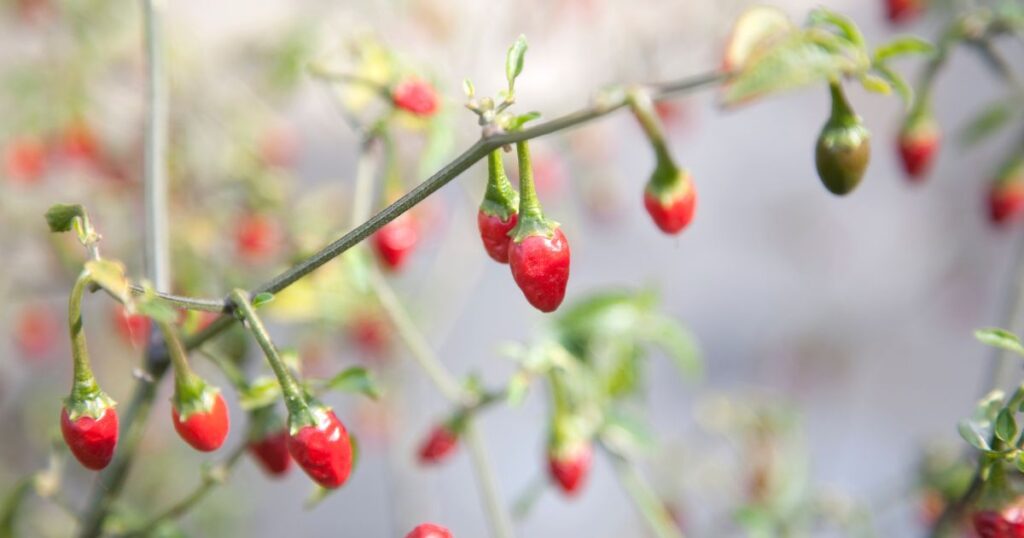
Are Pequin peppers healthy?
Pequin peppers, like their fiery relatives, are low in calories and high in fiber, making them a nutritious addition to your diet. They are also high in vitamin C, which boosts immune function, and vitamin A, essential for maintaining good vision and skin health.
Capsaicin, the compound that gives Pequin peppers their heat, is also present. Capsaicin is well-known for its anti-inflammatory properties and ability to relieve pain. Furthermore, research suggests capsaicin may boost metabolism, potentially aiding in weight management.
The intense spiciness of Pequin peppers, on the other hand, may cause digestive discomfort in some people. If you experience discomfort after eating these peppers, reduce your intake or avoid them entirely.
Furthermore, due to the potent heat of Pequin peppers, they are frequently consumed in small quantities. As a result, while they are nutritious, your nutritional benefits may be limited due to the small serving sizes.
🔄 ALTERNATIVES AND SUBSTITUTES
What’s a good Pequin pepper alternative?
If you’re looking for Pequin pepper alternatives, several options cater to various heat tolerances. For example, Thai chili peppers have a higher spice level than Pequin peppers. However, these petite, thin peppers pack a punch of heat and blend seamlessly into sauces and stir-fries, making them a potent option for those looking for extra heat in their dishes.
Chipotle peppers, which are dried, smoked jalapenos, have a milder spiciness and a smoky flavor that works well in chilis and stews. Poblano peppers can reduce the heat even further; they add a touch of spice to salsas, sauces, and stews without overwhelming the palate.
Anaheim peppers are a versatile mild alternative that can work in many recipes. To reduce the heat, make sure to remove the seeds and membranes. In addition, Anaheim peppers add a subtle spiciness to the dish that doesn’t overpower it, making them an excellent substitute for those who prefer milder heat.
How do you pronounce Pequin Peppers?
Pequin peppers are pronounced as PEE-kin PEH-pers.
🙋 FREQUENTLY ASKED QUESTIONS
FAQ about pequin peppers
Are pequin peppers hot?
Yes. Pequin peppers are indeed hot. They rank between 30,000 to 60,000 on the Scoville Heat Scale, which measures the hotness of chili peppers. This heat level is similar to cayenne peppers and hotter than jalapeños, making them a fiery addition to any dish.
Are pequin peppers hotter than habanero?
While Pequin peppers are extremely hot but not as hot as habanero peppers, Habanero peppers have a Scoville heat unit (SHU) range of 100,000 to 350,000, making them several times hotter than Pequin peppers.
What’s the difference between Pequin pepper and jalapeño?
Pequin peppers and jalapeños differ significantly in size, heat, and flavor. Pequin peppers are small, round, or oval, with a smoky, fruity flavor. Furthermore, they are hotter than jalapenos, with Scoville values ranging from 30,000 to 60,000. In contrast, jalapenos are larger, have a milder heat (2,500-8,000 Scoville units), and have a crisp, bright flavor.
What’s the difference between Chile Pequin and Chiletepins?
Chile Pequin and Chiletepins are similar peppers frequently confused due to regional naming differences. Both peppers are small, round, or slightly oval and have a spicy heat level. However, there can be subtle differences in flavor, with chile Pequin having a fruity, smoky flavor and chiletepins having a more nutty, earthy flavor.
The flavor profiles of the two are also noticeably different. The Pequin pepper has a smoky, fruity flavor with hints of citrus and nutty undertones, whereas the Chiltepin has a quick, intense heat with an earthy and nutty flavor.
How high is Chili Pequin's cold tolerance?
Chili Pequin plants are relatively cold hardy for pepper plants. They can live in temperatures as low as 32 degrees Fahrenheit (0 degrees Celsius). However, they prefer a warmer climate with temperatures above 50 degrees Fahrenheit (10 degrees Celsius) for optimal growth and pepper production.
Can you grow Pequin peppers indoors
Pequin peppers can be grown indoors. Pequin peppers, like other chili pepper varieties, thrive in warm, well-lit conditions. As a result, you can grow these peppers indoors with sufficient sunlight or artificial grow lights, well-draining soil, and proper care.
Why are the Chile Pequin plant's leaves turning yellow and curling?
Yellowing and curling leaves on a Chile Pequin plant could indicate various problems. Leaf stress can be caused by overwatering or underwatering. Inadequate sunlight can also cause yellowing of the leaves. Other potential causes include pests, diseases, and nutrient deficiencies. As a result, accurate diagnosis of the problem is critical for effective treatment.
